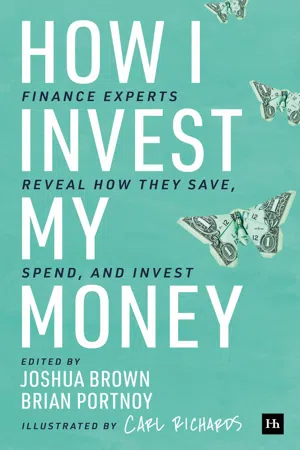
How I Invest My Money
Finance experts reveal how they save, spend, and invest
- English
- ePUB (mobile friendly)
- Available on iOS & Android
How I Invest My Money
Finance experts reveal how they save, spend, and invest
About this book
The world of investing normally sees experts telling us the 'right' way to manage our money. How often do these experts pull back the curtain and tell us how they invest their own money? Never.How I Invest My Money changes that.In this unprecedented collection, 25 financial experts share how they navigate markets with their own capital. In this honest rendering of how they invest, save, spend, give, and borrow, this group of portfolio managers, financial advisors, venture capitalists and other experts detail the 'how' and the 'why' of their investments. They share stories about their childhood, their families, the struggles they face and the aspirations they hold. Sometimes raw, always revealing, these stories detail the indelible relationship between our money and our values.Taken as a whole, these essays powerfully demonstrate that there is no single 'right' way to save, spend, and invest. We see a kaleidoscope of perspectives on stocks, bonds, real assets, funds, charity, and other means of achieving the life one desires. With engaging illustrations throughout by Carl Richards, How I Invest My Money inspires readers to think creatively about their financial decisions and how money figures in the broader quest for a contented life.With contributions from:Morgan Housel, Christine Benz, Brian Portnoy, Joshua Brown, Bob Seawright, Carolyn McClanahan, Tyrone Ross, Dasarte Yarnway, Nina O'Neal, Debbie Freeman, Shirl Penney, Ted Seides, Ashby Daniels, Blair duQuesnay, Leighann Miko, Perth Tolle, Josh Rogers, Jenny Harrington, Mike Underhill, Dan Egan, Howard Lindzon, Ryan Krueger, Lazetta Rainey Braxton, Rita Cheng, Alex Chalekian
Frequently asked questions
- Essential is ideal for learners and professionals who enjoy exploring a wide range of subjects. Access the Essential Library with 800,000+ trusted titles and best-sellers across business, personal growth, and the humanities. Includes unlimited reading time and Standard Read Aloud voice.
- Complete: Perfect for advanced learners and researchers needing full, unrestricted access. Unlock 1.4M+ books across hundreds of subjects, including academic and specialized titles. The Complete Plan also includes advanced features like Premium Read Aloud and Research Assistant.
Please note we cannot support devices running on iOS 13 and Android 7 or earlier. Learn more about using the app.
Information

| What | Percent | Ex-HC percent | Percent stocks |
| Human capital | 75% | — | — |
| Retirement | 11% | 47% | 90% |
| House | 6% | 26% | — |
| Natural land | 3% | 11% | — |
| Emergency fund | 2% | 8% | 30% |
| Daughter college fund | 2% | 6% | — |
| Previous mistakes | 1% | 2% | 100% |
Table of contents
- Contents
- Introduction
- Morgan Housel
- Christine Benz
- Brian Portnoy
- Joshua Brown
- Bob Seawright
- Carolyn McClanahan
- Tyrone Ross
- Dasarte Yarnway
- Nina O’Neal
- Debbie Freeman
- Shirl Penney
- Ted Seides
- Ashby Daniels
- Blair duQuesnay
- Leighann Miko
- Perth Tolle
- Joshua Rogers
- Jenny Harrington
- Michael Underhill
- Dan Egan
- Howard Lindzon
- Ryan Krueger
- Lazetta Rainey Braxton
- Marguerita Cheng
- Alex Chalekian
- Conclusion
- Publishing details